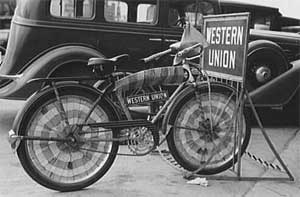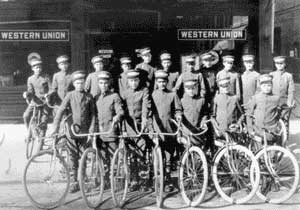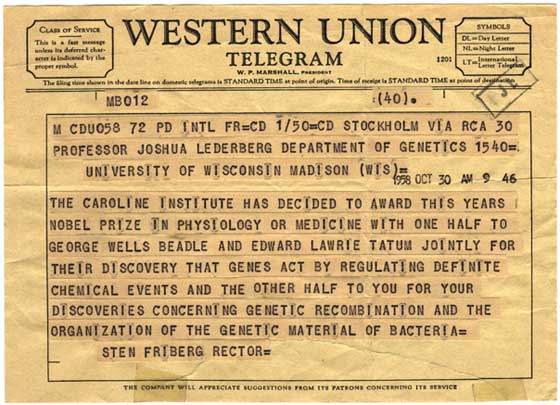|
(AP) - For more than 150 years, messages of joy, sorrow and success came in signature yellow envelopes hand delivered by a courier. Now the Western Union telegram is officially a thing of the past.
 |
| A Western Union courier's bicycle |
The company formed in April 1856 to exploit the hot technology of the telegraph to send cross-country messages in less than a day. It is now focusing its attention on money transfers and other financial services, and delivered its final telegram on Friday.
"The decision was a hard decision because we're fully aware of our heritage," Victor Chayet, a company spokesman said Wednesday. "But it's the final transition from a communications company to a financial services company."
Several telegraph companies that eventually combined to become Western Union were founded in 1851. Western Union built its first transcontinental telegraph line in 1861.
"At the time it was as incredible and astonishing as the computer when it first came out," said Tom Noel, a history professor at the University of Colorado at Denver. "For people who could barely understand it, here you had the magic of the electric force traveling by wire across the country."
In 1994, Western Union Financial Services was acquired by First Financial Management Corp., which First Data Corp. bought for $7 billion the following year. Last week, First Data said it would spin Western Union off as a separate company.
 |
| A Western Union fleet of couriers |
Telegrams reached their peak popularity in the 1920s and 1930s when it was cheaper to send a telegram than to place a long distance telephone call. People would save money by using the word "stop" instead of periods to end sentences because punctuation was extra while the four character word was free.
Telegrams were used to announce the first flight in 1903 and the start of World War I. During World War II, the sight of a Western Union courier was feared because the War Department, the precursor to the Department of Defense, used the company to notify families of the death of their loved ones serving in the military, Chayet said.
With long distance rates dropping and different technologies for communicating evolving — including the internet — Western Union phased out couriers in the late 1960s and early 1970s.
By last year, only 20,000 telegrams were sent at about $10 a message, mostly from companies using the service for formal notifications, Chayet said.
Last week, the last 10 telegrams included birthday wishes, condolences on the death of a loved one, notification of an emergency and several people trying to be the last to send a telegram.
"Recent generations didn't receive telegrams and didn't know you could send them," Chayet said.
Samuel Morse, inventor of the Morse code, sent the first telegram from Washington to Baltimore on May 26, 1844, to his partner Alfred Vail to usher in the telegram era that displaced the Pony Express. It read "WHAT HATH GOD WROUGHT?"
"If he only knew," Chayet said of the myriad choices today, which includes text message on cell phones, the internet and virtually free long-distance calling rates.
"It definitely was an anachronism," Noel said. "It's amazing it survived this long."
Below: A 1958 Telegram to Professor Joshua Lederberg about a Nobel Prize Award

Back
to Main News Page |